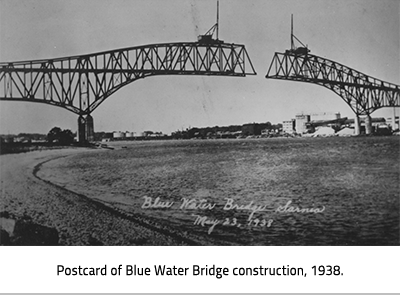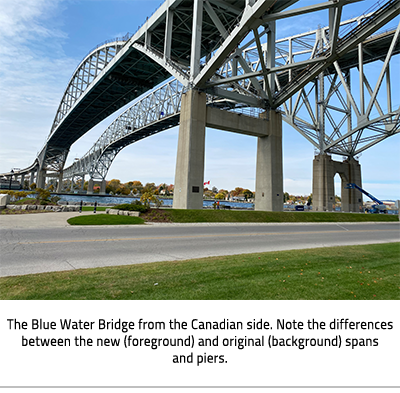The Blue Water Bridge
 The twin spans of the Blue Water Bridge are an iconic Lambton County landmark. The bridge arcs gracefully over the blue-green waters of the St. Clair River. First Nations have gathered for millennia at this place where Lake Huron flows into the St. Clair River. Today the base of the bridge is a great place to go for a walk, eat French fries, or watch the ships and recreational boaters.
The twin spans of the Blue Water Bridge are an iconic Lambton County landmark. The bridge arcs gracefully over the blue-green waters of the St. Clair River. First Nations have gathered for millennia at this place where Lake Huron flows into the St. Clair River. Today the base of the bridge is a great place to go for a walk, eat French fries, or watch the ships and recreational boaters.
The story of the bridge construction follows a tradition of engineering innovations in Sarnia and Point Edward. In 1891, the St. Clair Tunnel opened between Sarnia and Port Huron. This remarkable feat of engineering created a submarine rail link between Canada and the United States. About 40 years later, in 1927, the first plans were made to build a bridge across the St. Clair River. With the growing popularity of the automobile, a road connection was now a necessity.
After years of planning and delays, construction moved forward. Matching superstructures were built simultaneously from Port Huron and Point Edward. On May 24, 1938, hundreds of people gathered to watch the placement of the first piece of steel that would connect the Canadian and American sides. B.B. "Buck" Buchanan, a construction worker, walked the length of the emerging bridge. He became the first person to cross the 1,883m bridge from Canada to the United States.
The Blue Water Bridge officially opened to pedestrians on October 8, 1938 (and traffic 2 days later). Ontario Premier M.F. Hepburn and Michigan Governor Frank Murphy met at the international boundary for a ribbon-cutting ceremony. Festivities included a marathon, a parade, a sailboat race, music, and a fireworks display.
By the 1990s traffic flow across the bridge was very heavy. Instead of widening or replacing the original bridge, a twin span was proposed. Construction of the second span of the Blue Water Bridge uncovered thousands of artifacts and disturbed sacred burial grounds. Archaeologists catalogued and removed the artifacts, and repatriated the remains. The second span opened on July 12, 1997. As in 1938, residents from both sides of the river were invited to walk across the bridge. Approximately 75,000 people took part.
Land near the base of the bridge was set aside to commemorate the site’s long history of gathering. The Souls Memorial, sculpted by Dennis Henry-Shawnoo of the Kettle and Stony Point First Nation, is the centerpiece of a circular landscape that is a living representation of the Anishnaabek Medicine Wheel. The Souls Memorial recognizes the ongoing spirit of friendship and respect that exists between Aamjiwnaang First Nation and the Federal Bridge Corporation Limited. For more information see The Souls Memorial by historian and writer, David D. Plain.
It is easy to overlook the differences between the aesthetically similar spans. The original cantilever truss-style span was built of steel. The second span was built in half-through arch-style of steel and reinforced concrete. The north, westbound span is the original bridge. The south, eastbound span is its twin. The original span is notable for its complex truss pattern and decorative concrete piers. The second span has a simpler look and is slightly wider and higher.
At the start of 2020, about 14,000 vehicles crossed the Blue Water Bridge each day, including 6,000 trucks. The bridge is owned, operated, and managed by the Federal Bridge Corporation, along with several other border bridges. According to historian Edward Phelps, "In the Blue Water Bridge one sees a tangible example of the ongoing spirit of cooperation and friendship that has graced Sarnia and Port Huron throughout the course of their long history together."
Footage of Blue Water Bridge construction and opening ceremony.
Courtesy of Lambton County Archives



 Subscribe to this page
Subscribe to this page